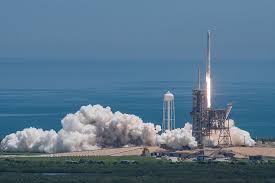 On Thursday, May 10th, SpaceX will be launching the latest version of their Falcon 9 rocket from the Kennedy Space Center in Florida (https://www.kennedyspacecenter.com/launches-and-events/events-calendar/2018/may/rocket-launch-spacex-bangabandhu-satellite-1), putting the Bangabandhu-1 satellite into orbit. This is Bangladesh’s first communications satellite, but the most revolutionary development is the Falcon 9 rocket itself.
On Thursday, May 10th, SpaceX will be launching the latest version of their Falcon 9 rocket from the Kennedy Space Center in Florida (https://www.kennedyspacecenter.com/launches-and-events/events-calendar/2018/may/rocket-launch-spacex-bangabandhu-satellite-1), putting the Bangabandhu-1 satellite into orbit. This is Bangladesh’s first communications satellite, but the most revolutionary development is the Falcon 9 rocket itself.
The Block 5 version of the Falcon 9 rocket is intended to be reusable, with broad implications for SpaceX specifically and the future of spacefaring in general (https://www.theverge.com/2018/5/9/17254384/spacex-falcon-9-block-5-upgrade-rocket-reusability-savings). Being able to land and relaunch a rocket will save the company untold quantities of money, and it’s estimated that this model can be reused anywhere from ten to 100 times. There are also safety benefits to utilizing rockets that have already been tested in flight.
The Falcon 9 model has previously been relaunched one time after use, but this is still costly as the ship must be disassembled, examined, and reassembled before being sent back into space. The Block 5 upgrade expedites this process, saving the company time and money in the long run. Elements like heat-resistant engines, sturdy titanium grid fins, and bolted components improve durability and make it easier for workers to dismantle and inspect the rocket’s interior.
With these new reusable rockets, SpaceX will see some changes in its staffing. Given that there will be fewer rockets to rebuild and that the existing ones will be much simpler to work on, there will likely be reductions in their workforce. This, along with the changes to the rocket itself, will mean $10 million to $15 million dollars saved, roughly 30% of the total budget. SpaceX intends to use this money for future projects.
Given NASA’s many struggles with budget and production (https://www.popularmechanics.com/space/a17083196/winners-and-losers-in-the-new-nasa-budget/), this development puts private spaceflight companies like SpaceX at a great advantage. However, it’s not all bad news for America’s federal space program. SpaceX will be using the Falcon 9 Block 5 rocket to send American astronauts to the International Space Station. The approval of these projects from NASA signals even greater opportunities, both commercial and scientific, in SpaceX’s future.





